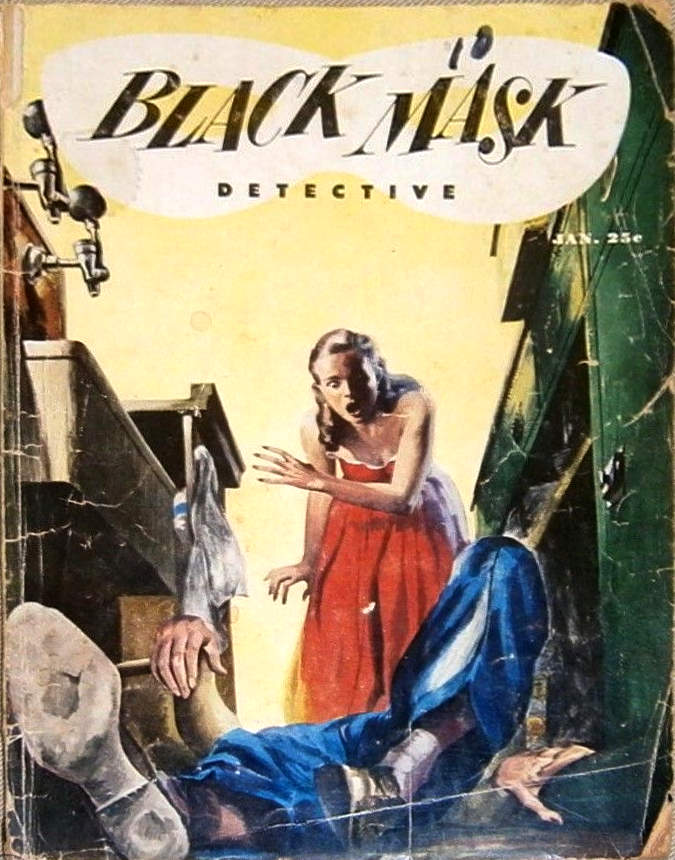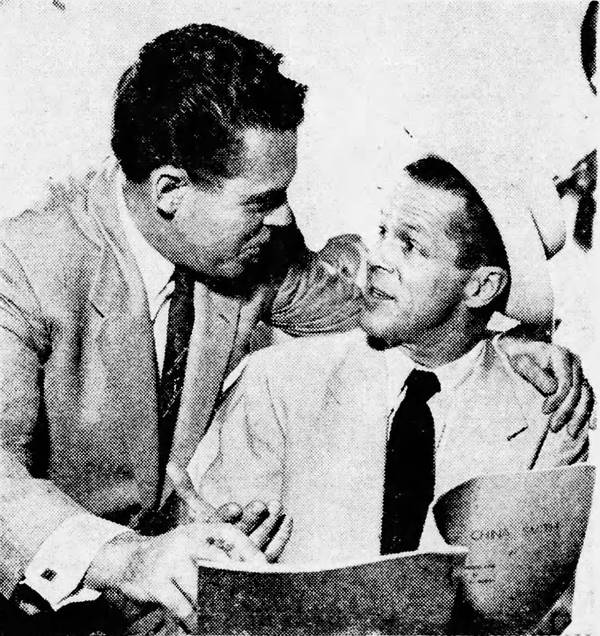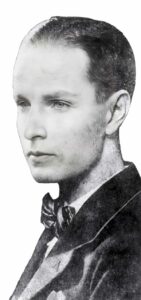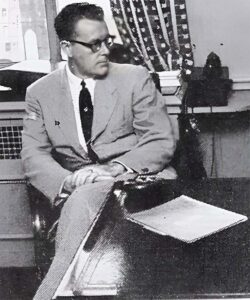Earlier in this series of Black Mask reviews, we took a look at issues from the 1920s, 1930s, 1940s and 1950s. Here’s one from 1951 when the whole industry was on its last legs and most titles were only a few issues away from sudden death.

The first thing you see is the logo, unrecognizably altered. On the cover a woman is looking at a man lying behind a bar counter. The man’s shoes have a hole in one sole; the woman is a blonde in a red dress looking shocked. Nothing to do with any story. The paper is pulp but less coarse and the covers are slick both inside and outside.
Lean and Mean
Popular had to cut costs if the magazine was to be profitable.
- Reduced page count (128 pages to 112)
- Reduced size (7 x 10 inches to 6¼ x 8½ inches)
- Less words (A reduction of about one third)
- Less original fiction (40% by page count, the remaining pages containing reprints)
- No interior illustrations
The price was still a quarter. On the plus side, the edges are trimmed and there are no ads. Popular was trying to make the pulps slightly classier looking, cheaper to produce and profitable. Would readers buy into the new formula?
Flattery
It might have helped if they still had Chandler or Hammett around to write for them. But Hammett had left Black Mask in 1930, and Chandler had written his last pulp story in 1941. Still, the duo had made a big splash and the ripples of their impact had brought out a wave of imitators. And if they couldn’t get the real deal, Popular would give you “You can’t believe it’s not better”.
Dean Evans (real name George F Kull) was one of the imitators. I’ve read one story by him and briefly flipped through a few others I could find online, most look like Chandler pastiches. Scandal-time gal starts with:
Election day was just two weeks off and the weather should have been cool. Instead there was a big red balloon of a sun in the sky. It was one of those suns they should keep tied up out in the middle of the desert: a sun that makes varnished Morocco out of your hide while it melts down the nails in your shoes. When the sun beats down like that, you can drink one small beer, step outside and fall flat on your face. A sun like that makes a man do crazy things.
Here’s Chandler’s original for comparison:
There was a desert wind blowing that night. It was one of those hot dry Santa Anas that come down through the mountain passes and curl your hair and make your nerves jump and your skin itch. On nights like that every booze party ends in a fight. Meek little wives feel the edge of the carving knife and study their husbands’ necks. Anything can happen. You can even get a full glass of beer at a cocktail lounge.
The plot itself is a rehash of Red Wind, with some variations. It has, like Chandler’s story, its share of loose ends and unexplainable actions. Unlike Chandler, it doesn’t have prose that lifts the story and floats it over the p(l)otholes. I wouldn’t go out of my way to read it.

Canadian born pulpster, radio and Hollywood writer Robert C. Dennis (1915-1983) was more successful in his attempt to copy a master in I Thee Kill, in his case Cornell Woolrich. A man wakes up to find an invitation to his ex-girlfriend’s wedding slid under his door. He still carries a torch for her; she doesn’t. He wonders why she invited him and goes anyway, only to see the bridegroom shot on the steps of the church.
He comes back to his house, finds the murder weapon inside and disposes of it in a nearby trashcan as police cars with sirens converge on his house. He runs to a nearby church and goes into the confessional, hoping the priest can help him. As he comes out it’s raining and he picks up an umbrella near the door, only to find out that it’s the umbrella through which that gunshot was fired. The evidence against him is increasing. With no place to hide, he goes back home after the police have left. As he tries to sleep he hears a voice telling him that he’ll be caught and executed.
Good beginning, and if he had managed to keep it up, I’d have said this was good. But the middle and ending are weak. But then, so were some of the master’s own stories. I’d rate this as mid-grade Woolrich. Worth reading once.
Classics Unillustrated

Woolrich himself was in the issue with He looked like murder, which had been made into a movie, The Guilty, in 1947. A reprint from a 1941 issue of Detective Fiction Weekly, this was an attempt by Popular to get a big name into this issue and use the Munsey publishing assets they bought in 1942. The story is high-grade Woolrich, so you wouldn’t complain. I’d review the story, but someone else already did it well, and I’m lazy. You can hear the story here.

The Banshee by prolific writer Richard Sale is a nice change of pace from the pits of despair that Woolrich pulls us into. Another reprint, also from Detective Fiction Weekly; this one features one of his series characters, Candid Jones, a photographer who helps the police. Who come to him this time with a real doozy – an authentic photo of an Irish banshee emerging from a pool in an aquarium at night.
It was as ghastly as any spook you’ve ever dreamed about. It wasn’t one of those things in a white sheet that goes around clinking chains and knocking on wood for spiritualists. This was ectoplasm, a shimmying welt of white stuff which slithered up out of the bubbling water of the penguin pool to form a figure, utterly transparent (you could see the albacore tank on the far wall beyond it right through its middle) yet with a curious breadth of body that was disturbing. It narrowed into nothing at its foot and spread into a pair of shoulders at its top. There was no head. The head dissipated into thin black air. There were two arms, distorted and baroque things, misshapen and deformed and pretty horrible, with jagged ends and no break at any elbow. The thing had the damnable appearance of a bride without a head. It was a nasty bit and I couldn’t repress a slight shiver.
Sale has fun with the idea of hunting down a real banshee but this is Detective Fiction, not Dime Mystery. The explanation is plausible but overcomplicated for a bunch of unimaginative crooks. A letdown.
Robert Turner (1915-1980) was a professional writer who started in the pulps and went on to write paperbacks, movie and TV scripts and two guides to writing for entertainment: Pulp Fiction and the much more memorable title, Some of My Best Friends Are Writers but I Wouldn’t Want My Daughter to Marry One. I have the first, and much to my regret, not the second.
His For the rest of your death begins with a police commissioner thinking about his wife of twenty years, who he’s just shot dead. He mistook her for a burglar; she was standing in front of his safe that contained vital evidence in a case he was discussing with their house guest, the district attorney. It’s gnawing at him: Why was she there, late at night with the lights off? Was she trying to tamper with the evidence? Was she having an assignation? Will he ever find out the real reason? A reasonable story for a change.
The rest of the stories are reprints from Detective Fiction Weekly. Robert Arthur’s The Coroner’s Hand is from 1939. Average.
Fred Nebel’s The Green Widow (1933) is fun. Everyone except his boss and colleagues underestimate Sgt. Brinkhaus. Brinkhaus doesn’t make Holmes’ intuitive leaps but takes nothing for granted, plodding his way to the truth with every clue. Trust Nebel to make this unlikely sounding idea into a slow burning thriller.
Here Brinkhaus has to deal with the robbery of a million-dollar (in today’s money) emerald. It was displayed in the jeweler’s window; a woman accomplice distracted the cops on the beat while the robber broke the window and grabbed the gem. Brinkhaus interviews everyone in the firm; the tubercular clerk acts suspicious and is the most likely candidate for investigation. But the gem’s owner tells Brinkhaus to back off. The ambitious DA is trying to show up the police for inefficiency and boost his career, the policeman on the beat has been suspended without pay and this gives Brinkhaus enough motivation to power a train. Nice ending and made me want to read more Brinkhaus.
Luckily, Steeger Books released all the Brinkhaus stories in one volume.
Letter to the readers

Would you pay twelve bucks for it on the newsstand today? You would? I would too, but then I might not buy another issue. This issue is a letdown; Black Mask was a top-tier name and readers expected better.
Manhunt, launched a couple of years later, led the digest revolution with the higher price of 35 cents. But its content was all original, and it had one illustration per story. Black Mask died after three more issues; it’s one of those what-if moments that make you wonder what would have happened if they had got the formula right.
Have we seen the last of Black Mask?
Next week: Once more on the newsstand
I like even warmed over Chandler, so for the most part I like most stories by Dean Evans and Robert C. Dennis. But I avoid reprints. However the editors seem to have picked good ones by Woolrich, Nebel, and Richard Sale.
I bought the revived Black Mask back in, I believe 1974. 50 years ago! Looking forward to your essay on it.
Yeah the reprints were good. The originals could have been, with a little work, better than average. That is what they were, though, and not worth a quarter. The reprints were good, though, and one wonders if readers would have taken to a classic crime magazine in this format.
THANK YOU SO MUCH for these rundowns! EXCELLENT!
You said, “if they’d gotten the formula right.” I don’t think any formula existed. Short of turning pulp pages to gold, nothing would have worked. Like today and the change in attitudes toward previous media, they had no audience left to convince. Everyone had already left. No ads really tells the story. Radio had taken everyone, and TV would soon steal the rest and the radio audiences, too. But GREAT work, and keep them coming!! Thanks again!
Sexy covers, harder-boiled/noir fiction, two tone interior illustrations and a marquee name in Mickey Spillane definitely helped Manhunt in 1953, just two years later.My own feeling is that the tinkering didn’t work because Popular invested too little in the new format. Who can blame them, though?